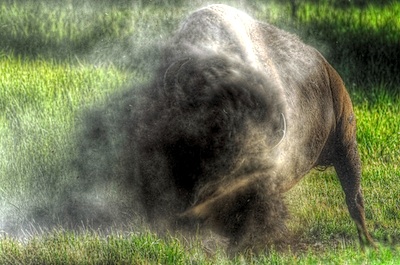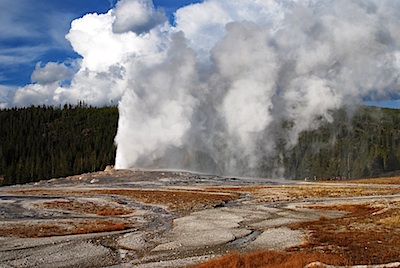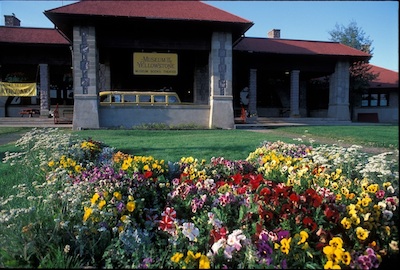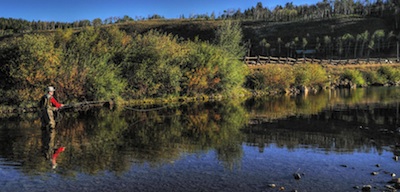
Fall’s golden mantle is draped across aspen glades on the mountainsides in Yellowstone and surrounding West Yellowstone / Michael Polkowske
Fall. Its days are waning. The gold of aspens are fluttering in the breezes, making their last salute before falling into winter. The growing crispness gripping the air is driving off the insects, making for superb hiking and biking weather, while wildlife, well-aware of the season, are easily seen on the move towards wintering grounds.
These wonderful months near year’s end, it can be argued, are the best of the year in Yellowstone National Park. And why not? The weather generally is outstanding, the scent of autumn invigorating, the hiking and photography options spectacular.
All this unfolds on the front doorstep of West Yellowstone, Montana, a small, friendly town fringed by parklands and national forest that is well-versed in making visitors feel welcome, having greeted the first more than a century ago. You would figure the locals have hospitality down, and they do.
Make your base camp here and the national park and the outdoors are almost literally at arm’s reach, sometimes requiring nothing more than a short walk from your room. That lodging might be a simple hotel room, or a charming log cabin with room for the whole family and a wood-burning stove or fireplace to help ward off the season’s growing chill. Family suites and fall season lodging discounts allow you to save some money while cooking your own meals, or you can rely on the diverse array of eateries in town for hearty meals.
Though Yellowstone’s high season has passed, there remains much to do and see, from wildlife watching and cycling tours to angling for trout or strolling the Norris Geyser Basin before winter sets in.
Wildlife, And Their Watchers, On The Move
They are in motion before the first blush of dawn, and at day’s end as well, gathering in Yellowstone’s meadows and along the rivers that drain the park. Often they arrive early and stay late, anxious to catch the spectral bugling that cuts through the air and rings across the landscape.
“They,” of course, are the wildlife watchers. Come fall, you need to be either an early riser, or have a late dinner, to catch the bull elk calling their harems together with their unique melody, a high-pitched whistle that descends into a guttural wheeze.

Bison are magnificent to watch...just keep your distance. / Michael Polkowske
Bugling elk are, for many, the main attraction of the fall season. Both the bulls’ shrill calls and their fierce antler-to-antler battles create memories not soon forgotten.
A short, enjoyable hike along the mile-long Riverside Trail from downtown West Yellowstone (the trailhead is on Boundary Street) into the park offers the chance to both catch this fall concerto and savor either the rising sun, or the setting sun, as its slanting rays shimmer across the lazy bends of the Madison River.
The short drive into the park through the West Entrance and along the Madison River opens up more opportunities for encountering these displays. Pull over at Seven Mile Bridge, park the car, and get out to spend some time listening to the bulls’ competing choruses. Down in the river, if your timing is right, you just might spot a moose.
As you drive into the park, watch out for bison, as they are on the move as well. Having gone through their rut in August, these shaggy animals are heading towards the river valleys for the winter months. Their herds can jam traffic in Gibbon Canyon, as well as in the Hayden Valley, as the bulls, cows, and calves are unfazed by vehicles. They know winter is on the way, and are focused on finding the best, last grass of the season, undeterred by traffic.
Overhead, raptors are on the move, too, heading south on their migratory exodus. Red-tailed hawks, bald eagles, ospreys, and American kestrels often can be seen winging through the Hayden Valley.
Not interested in leaving are such year-round Yellowstone residents as mallards, green-winged teal, majestic trumpeter swans, and even great blue herons, which you just might spot in some of the park’s ponds and marshy areas. Stop by the West Yellowstone Visitor Center to pick up a brochure on where best to look for birds in the area. It just might help you catch common loons calling across lake waters.
Photographing The Best Side Of Yellowstone
Nature photographers don’t sleep well. They know when the best light is cast on the landscape and when animals are about. So they rise early, often right at or even before dawn, rest during midday, and then head back out until the last glimmer of daylight flickers across the western horizon.
Fall’s soft early morning and late afternoon sunlight make the parklands and forests surrounding West Yellowstone a photographer’s favorite landscape. While the gold of aspens and reds of maples add contrast to the green lodgepole forests, wildlife seem more than willing to pose for you. Bull elk congregating in meadows easily fill frames with their massive antlers, while bison contentedly chewing their cud or kicking up dust in a wallow offer more prime focal points.
But while bison look ponderous and lazy, they can summon surprising bursts of speed of more than 30 mph. With their horns and bulk they can do substantial damage to your vehicle, and inflict serious injuries to you, if you don’t keep your distance. Inside the park, that means staying at least 100 yards from wolves and bears and at least 25 yards from elk, bison, bighorn sheep, pronghorn, and mule deer.

Grasses surrounding Old Faithful put on their fall best to contrast with the geyser’s billowing steam / Kurt Repanshek
After filling your camera’s flash cards with wildlife images, head to one of the geyser basins and you can add tendrils of steam and skying columns of boiling water to your photographic collection. By altering your perspective, either by shooting pictures from ground level or by hiking up in elevation and shooting back down on the sprawling setting of geysers and colorful hot springs, you can add even more depth and originality to your vacation photos.
Another bonus of fall photography is that summer’s crowds are gone. As a result, you’re not jockeying to improve your line of vision, or rushed to keep moving around the boardwalk in the geyser basins. Instead you can relax while composing your shot...or simply enjoy watching the geysers and hot springs seethe, gurgle, sputter, and boil.
If you’d like some pointers on where to capture the best images, West Yellowstone has a number of photography businesses that can lead you on photo safaris in the park.
Ride Your Bike, Or Take A Hike
Coming to Yellowstone means getting out and enjoying the landscape, wildlife, and thermal features. Got a road bike? Consider joining the 2014 peloton for a 60-mile roundtrip from West Yellowstone to Old Faithful and back during the annual cycle tour of the park in September.
This ride is limited to 350 participants and quickly fills up, so watch for the reservation window next June. You’ll follow the Madison River from West Yellowstone to Madison Junction, then turn south and head to Old Faithful, the steaming Firehole River on your right as you cruise through the Lower and Midway geyser basins.
Don’t worry about packing snacks, as there are feed stations along the route, and even a sag wagon to give you a lift if the elevation or distance get to you.
Prefer cruising through forests on your mountain bike? Head for the 35 kilometers of trails weaving through the Gallatin National Forest on the Rendezvous Trails System that adjoins town. The trailhead at the south end of Geyser Street ushers you into a maze of loops that roll, dip, and climb with the forest (come back in winter to ski the trails!).
Worrying about the 6,600-foot elevation? Take a trail map with you and you’ll see the cutoffs that can help you take it easy on your lungs. Fall walks can be as mellow as a meandering tour of downtown West Yellowstone with its quaint shops, art galleries, and jewelers, to a day-long affair hiking down to Shoshone Lake in Yellowstone.

Gain your bearings at the Yellowstone Historic Center in West Yellowstone.
In-between mileage can be logged walking through the geyser basins: the Norris Geyser Basin is the park’s hottest and offers the most colorful mudpots, while the Upper Geyser Basin is home to Old Faithful, Giantess, Riverside, and Castle geysers, as well as countless other hot springs and geysers. A few hours could be spent hiking to Mystic Falls up behind Biscuit Basin, while a longer excursion could involve a 7-mile roundtrip hike to Spray and Imperial geysers near the Midway Geyser Basin.
On hikes in geyserland the cooler fall temperatures often reveal thermal features you otherwise might have missed, as the warm mists they vent billow more visibly in the season’s colder air.
Relaxing In Town
Everybody deserves a down day, one spent without worries of rushing someplace or filling the day driving from one spot to the next.
West Yellowstone can handle those days. Stroll over to the Grizzly & Wolf Discovery Center on South Canyon Street and you’ll not only come away with a better understanding of wolves and grizzly bears, but with photos of some of the bears and wolves that live out in the open here. In the Yellowstone Historic Center, housed in a handsomely restored railroad depot that dates to 1909, you can come away with an understanding of the historic wildfires that swept across a good portion of the park during the summer of 1988, and delve into the roots of this gateway town.
There are painstakingly restored stagecoaches in the center, and carefully detailed exhibits on fly fishing, which isn’t too odd when you consider the trout streams in the area. Ranked by Forbes magazine as one of the top 10 fishing towns in the country, West Yellowstone is within easy reach of the Madison, Gallatin, and Yellowstone rivers, as well as the Henrys Fork of the Snake River, with their rainbow, Yellowstone cutthroat, and brown trout fisheries.
The Center is open through mid-October and features some great events, such as a “Night at the Museum” on September 7 when you can explore the museum by flashlight, and a “Brat Night” on October 5 when you can find dinner there.

West Yellowstone is renowned for its nearby trout streams, such as Grayling Creek / Michael Polkowske
You can stretch your legs with a walk around town, one that will take you by the historic district, and connect you with the Rendezvous Trails System, or which can be extended to create a nearly 4-mile loop that you can either jog or ride your bike along. This approach allows you to crisscross the downtown area in search of the perfect souvenirs to take home.
Need a hat to shield your head from the sun, or a warm fleece? Stop by Eagle’s Store, which has been in the same family serving the needs of travelers since 1908 from its location on Canyon Street. Want a book on Yellowstone’s natural or human history? Stroll down the aisles in The Book Peddler, also on Canyon.
Antiques, including some vintage flyfishing collectibles, can be found at Once in A Blue Moon on Madison Avenue. Western-themed gifts and postcards, just to name some of the merchandise, can be found at Smith & Chandler on Yellowstone Avenue across from the historic center.
By the time your trip comes to an end, you’ll appreciate that fall enjoyed in West Yellowstone and its namesake national park offers a rich array of activities and experiences guaranteed to create memories…and convince you to return to enjoy the other seasons from this base camp.



Comments
Elk bugling. Ha. One of the most sleepless nights I've ever spent was a night in October at the Mammoth Hotel, with a bull elk bugling directly under my window all night.
I love elk, don't get me wrong, but that sound has never had the same ring for me since that night.